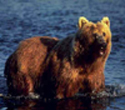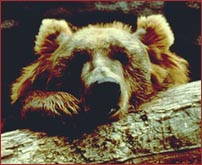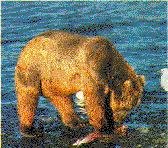Diet
 As
with most other brown bears, the Kodiak brown
bear can eat anything that it can digest and is
edible. During the summer Kodiak bears store up
80 to 90 pounds per day from dietary intakes so
that it can gain enough weight and fat to survive
hibernation during the winter. Kodiak females,
that are pregnant, have to consume more than 90
pounds of food to be able to perform hibernation
and to be able to give birth and feed her cubs
wholesome milk. As
with most other brown bears, the Kodiak brown
bear can eat anything that it can digest and is
edible. During the summer Kodiak bears store up
80 to 90 pounds per day from dietary intakes so
that it can gain enough weight and fat to survive
hibernation during the winter. Kodiak females,
that are pregnant, have to consume more than 90
pounds of food to be able to perform hibernation
and to be able to give birth and feed her cubs
wholesome milk.Kodiak bears are heavy eaters,
but during the spring and before the spawning
salmon season begins they eat about 50 pounds of
food per day. This low intake, compared to their
summer dietary intake, is due to many factors,
some of, which include the climate, abundance of
food and the availability of food that contains a
high amount of fat and nutrients.
Most of the food that a Kodiak bear eats is
plant material, which seems to label the Kodiak
as a herbivore, but the remaining dietary intake
of this animal comes directly from the fish,
carrion and occasional game animal that they eat.
The Kodiak bear's vegetation intake usually comes
from wild relatives of the carrot, lettuce,
berries and various types of grasses.
 When the spawning salmon
season begins in Alaska, Kodiak bears digest
approximately 50% more food than it ate during
the spring. This increase of food intake is due
to the abundance of salmon and the nutritional
value that it possesses. Depending on the amount
of salmon available, the Kodiak bear usually
strips away all of the fish except for the
stomach, liver and intestines, which it leaves
for the scavengers that live in the same
environment. When the spawning salmon
season begins in Alaska, Kodiak bears digest
approximately 50% more food than it ate during
the spring. This increase of food intake is due
to the abundance of salmon and the nutritional
value that it possesses. Depending on the amount
of salmon available, the Kodiak bear usually
strips away all of the fish except for the
stomach, liver and intestines, which it leaves
for the scavengers that live in the same
environment.
All bears use different techniques and strategies
to catch fish, the most common of which is the
bear jumping headlong into the river and then
proceeding to claw their paws in the river. Other
techniques include the Kodiak waiting along an
area where the fish jump high enough for the bear
to grab it and the submarine technique.
This submarine technique involves the bear
submerging in the water, with only its ears above
the water. The Kodiak will then push itself
underwater, while wading up the river. While the
bear performs all of these measures it also will
simultaneously look for a fish, and if it finds
one it will simply swim at the fish with its jaws
open.
Kodiak bears will also scrounge through beach
drift, which includes seaweed, mollusks, crabs
and washed-up marine mammals, such as a whale and
sea lion. They also prey on young and sick moose
calves, deer, elk and caribou. It rarely chases
and hunts a healthy game animal because the game
animal will out run it in both short and long
distances. When a Kodiak kills a large animal
which is too large to be consumed all at once,
they will hide it from other animals in a
secluded area so they can return to it in the
near future to finish consuming the animal.
More than half of the yearly diet of Kodiak bears
consists of berries and grasses. Due to low
concentration of food value in single plants,
Kodiak bears have to eat a lot of plant material
to gain any weight.
 The claws of a Kodiak
bear, which is designed for digging, are used to
capture yet another prey for the Kodiak bear, the
marmot. The Kodiak bear captures these
underground animals by digging through areas that
the bear can sense as belonging to the marmot. The claws of a Kodiak
bear, which is designed for digging, are used to
capture yet another prey for the Kodiak bear, the
marmot. The Kodiak bear captures these
underground animals by digging through areas that
the bear can sense as belonging to the marmot.
The Kodiak bears' weight keeps it from being fast
enough to catch some healthy game animals, which
can run over 35 mph over short distances. Kodiak
bears are also not stealthy enough to sneak up
behind a game animal and kill it. There are a few
scenarios in which it is possible for the Kodiak
to attempt to catch a healthy game animal. The
most common scenario would be at river crossings,
at which the game animals do not pay attention to
their surroundings.
|

![]()
 As
with most other brown bears, the Kodiak brown
bear can eat anything that it can digest and is
edible. During the summer Kodiak bears store up
80 to 90 pounds per day from dietary intakes so
that it can gain enough weight and fat to survive
hibernation during the winter. Kodiak females,
that are pregnant, have to consume more than 90
pounds of food to be able to perform hibernation
and to be able to give birth and feed her cubs
wholesome milk.
As
with most other brown bears, the Kodiak brown
bear can eat anything that it can digest and is
edible. During the summer Kodiak bears store up
80 to 90 pounds per day from dietary intakes so
that it can gain enough weight and fat to survive
hibernation during the winter. Kodiak females,
that are pregnant, have to consume more than 90
pounds of food to be able to perform hibernation
and to be able to give birth and feed her cubs
wholesome milk. When the spawning salmon
season begins in Alaska, Kodiak bears digest
approximately 50% more food than it ate during
the spring. This increase of food intake is due
to the abundance of salmon and the nutritional
value that it possesses. Depending on the amount
of salmon available, the Kodiak bear usually
strips away all of the fish except for the
stomach, liver and intestines, which it leaves
for the scavengers that live in the same
environment.
When the spawning salmon
season begins in Alaska, Kodiak bears digest
approximately 50% more food than it ate during
the spring. This increase of food intake is due
to the abundance of salmon and the nutritional
value that it possesses. Depending on the amount
of salmon available, the Kodiak bear usually
strips away all of the fish except for the
stomach, liver and intestines, which it leaves
for the scavengers that live in the same
environment.  The claws of a Kodiak
bear, which is designed for digging, are used to
capture yet another prey for the Kodiak bear, the
marmot. The Kodiak bear captures these
underground animals by digging through areas that
the bear can sense as belonging to the marmot.
The claws of a Kodiak
bear, which is designed for digging, are used to
capture yet another prey for the Kodiak bear, the
marmot. The Kodiak bear captures these
underground animals by digging through areas that
the bear can sense as belonging to the marmot.